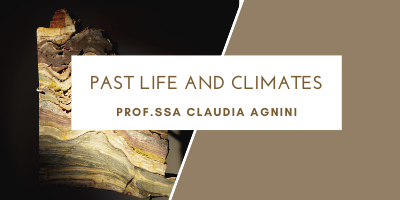Past Life and Climates

Period: first semester
Course unit contents:
1st Module: Past life
One of the basic tenets of geology is that the present is the key to the past. In recent years, however and especially considering the increasingly
important role played by humans in changing our Planet, scientists are turning that basic tenet around to the past is the key to the future. In this
perspective the reconstruction of past environments grounded on a proxy-based approach is one of the hot topics in the geosciences.
Proxies are physical, chemical and biological materials preserved within the geologic record that can be analyzed and correlated with climatic or
environmental conditions. Proxy-based reconstructions span all timescales, from year-to-year variations to those that occurred over millions of years and provide a tool in order better understand how climate and environments has varied trough time both before and after human-related alteration of the Earth.
In this context this course will be focused on:
1) Main geological archives (sediments, corals, trees, ice cores, speleothems, instrumental datasets). Completeness, Resolution and time frame.
2) Overview of main proxies in terms of their rationale, calibration (direct, indirect) and possible applications with the final aims to reconstruct past
environments and climates.
Proxies that will be presented in this course are subdivided in:
• Physical proxies
Sediment Composition. Types of minerals and fossils that are preserved in the geological archives and can inform about salinity, temperature, ice
cover, oxygen levels, nutrient levels, ect
• Biological proxies
Biological proxies that include remains of living organisms (terrestrial and marine) the distribution of which is controlled by temperature, moisture
availability, and other environmental factors.
Examples of biological proxies that will be treated during the course are:
- Terrestrial Biological Proxies: pollen and spores; plant macrofossils;
- Aquatic Biotic Proxies: foraminifers; calcareous nannofossils,
ostracodes, biogenic silica (diatoms, radiolarians and silicoflagellates),
corals, dinoflagellates cysts, mollusks;
• Chemical Proxies: composition of shells of aquatic organisms; biomarkers, elemental analysis
3) Applications of the basic information acquired in the first part of the course by means of a discussion of a case study that will change every
year and would serve to emphasize the potential of the fossil record in reconstructing environments in the geological past (e.g., modern
analogues) as well as interpreting changes observed in perturbated present day environments.
2nd Module: Past Climates
Climate-related issues are drawing an awareness that goes well beyond the mere scientific interest, as demonstrated by the extensive coverage
provided by mass media in this regard. Climate changes have indeed become a matter of popular debate, and their implications are felt as a
coercing problem for the survival of mankind and the Earth itself.
However, compelling evidences indicate that, since the early days of its Byr-long history, our planet had to cope unceasingly with changes in
regional and global climates, which occurred on different time scales and amplitudes. Hypotheses and models proposed so far cannot fully account
for the observed natural past climate variability, which remains to a large extent unexplained. On the other hand, predictive models proved to fall
short when attempting precise forecasts of future climate trends, since the Earth climate system is complex, manifold and hardly predictable in its
behavior. Therefore, based on the old “The past is the key to the future” adage, it is of the essence that future researchers, educators and
popularizers engaged in this field develop
1) a basic, yet critical, understanding of how the modern Earth climate system works, and
2) a broad knowledge on major long- and short-term climate changes and events that occurred in the deep and recent geologic past. In this regard, crucial insights are provided by investigating the climate history of the last 2 Myr, which can take advantage of a multitude of extensive, highresolution datasets.
Accordingly, Module 2 of the Course will be organized as follows:
Introduction to the Climate System (2.5 CFU).
Components of the Climate System. Elements of descriptive and dynamic Oceanography. The Thermohaline circulation.
Earth radiative balance. The Layer model. Greenhouse gases (GHG): definitions and properties.
The astronomical theory of climate. Orbital parameters and their stability in the Geologic Time.
Stable oxygen isotopes for paleoclimate reconstructions. From Urey to Shackleton: temperatures, sea-level and ice volume. δ18O stratigraphy O stratigraphy and MIS.
Stable carbon isotopes for paleoclimate reconstructions. The biochemical Carbon cycle. Ocean/atmosphere exchanges. δ13C and the global Ocean
circulation.
Past climates of the Earth (3 CFU)
- Proterozoic and Paleozoic
The Great Oxygenation Event. The Snowball and Slushball Earth
hypotheses. Paleozoic glaciations.
- Mesozoic
The Greenhouse world: from the Early Triassic wastelands to the
Cretaceous Thermal Maximum.
- Paleogene
The great early Cenozoic breakthrough: from Greenhouse to Icehouse.
The Southern Hemisphere Glaciation.
- Neogene
The Northern Hemisphere Glaciation. Ventilation crises in the
Mediterranean: sapropels. The paleoclimatic record of the last 2 Myr: long- and short-term variability and trends.
- Recent and modern climate variability
Dansgaard-Oeschger and Heinrich events. The Holocene: From the Minoan warm period to the Little Ice Age. Bond events. Modern climate
variability: possible causes, implications, and trends. Open discussion (class lab).
Planned learning activities and teaching methods:
1st Module: Past Life
Frontal lectures (5 CFU)
Class laboratories (1 CFU)
Lectures with the support of on-screen presentations. Lab classes (group work) for discussing a case study (different every year) + Lab classes to
give an overview of the main fossil groups (1st Module). A one-day field trip to outcrops where rocks with paleoclimatic significance are exposed
(2nd Module).
Frontal lectures (5 CFU = 40h)
Class laboratories (1 CFU = 16h)
Frontal lectures (5.5 CFU = 44h)
Class laboratories (0.5 CFU = 8O stratigraphy h)